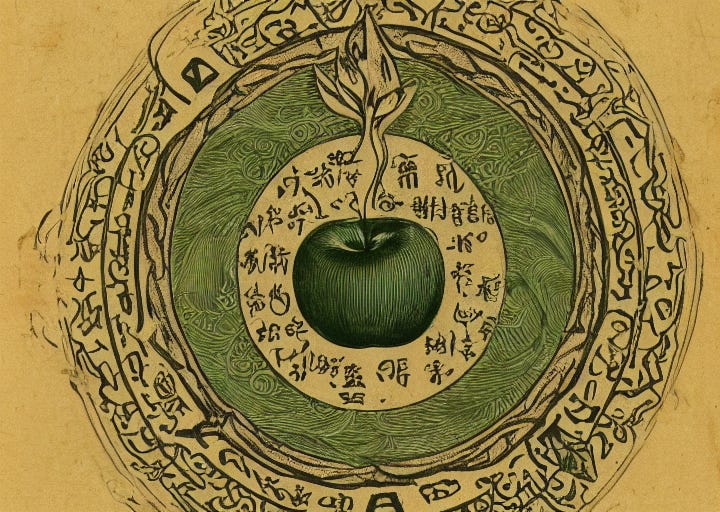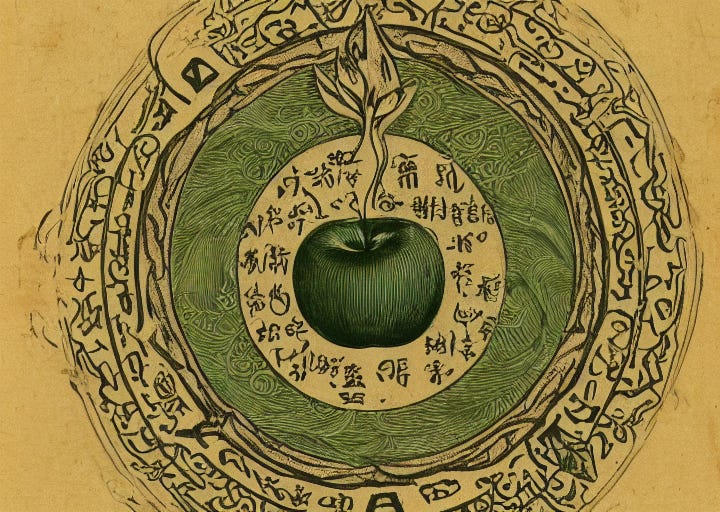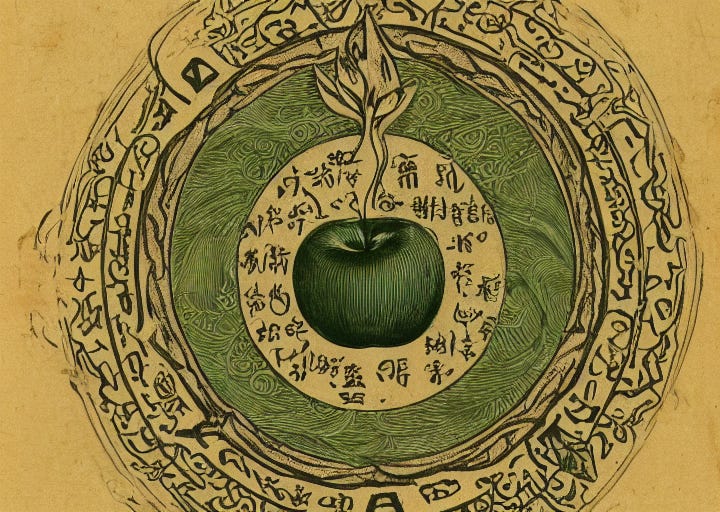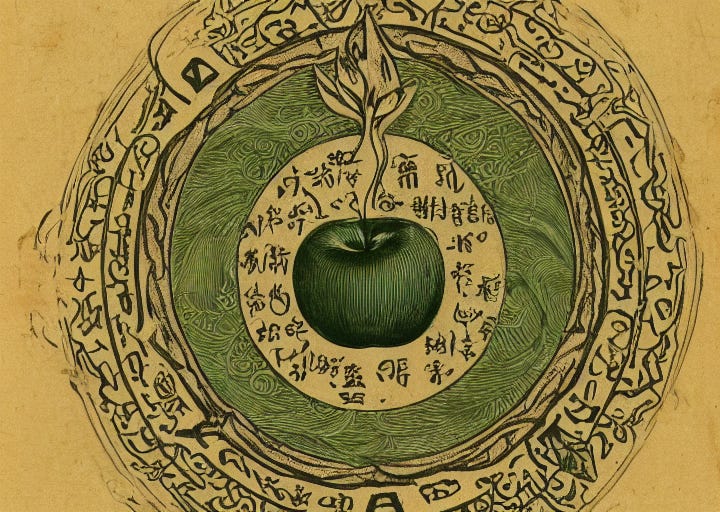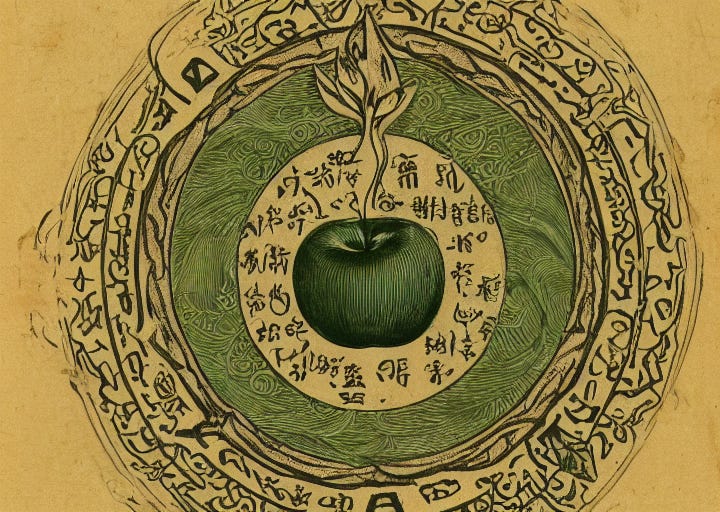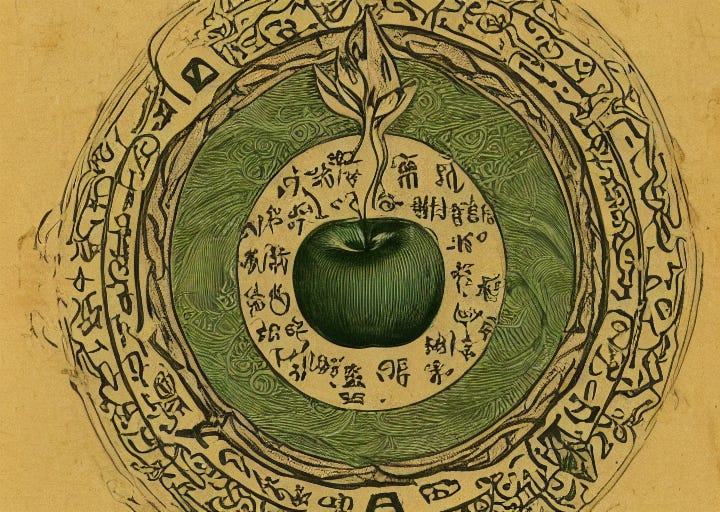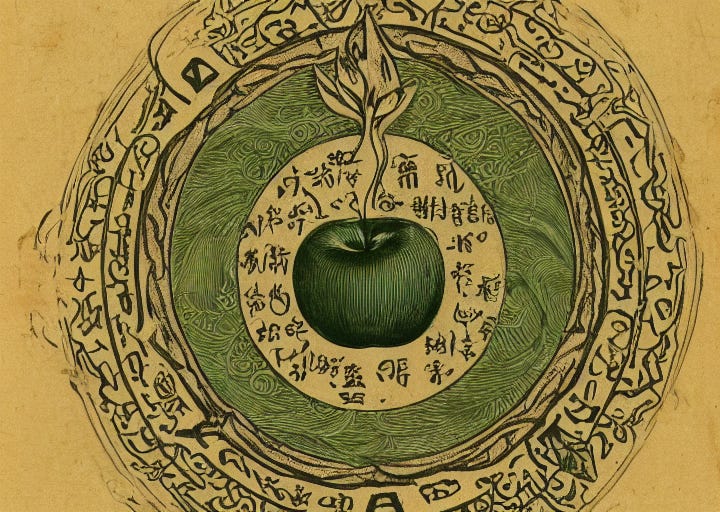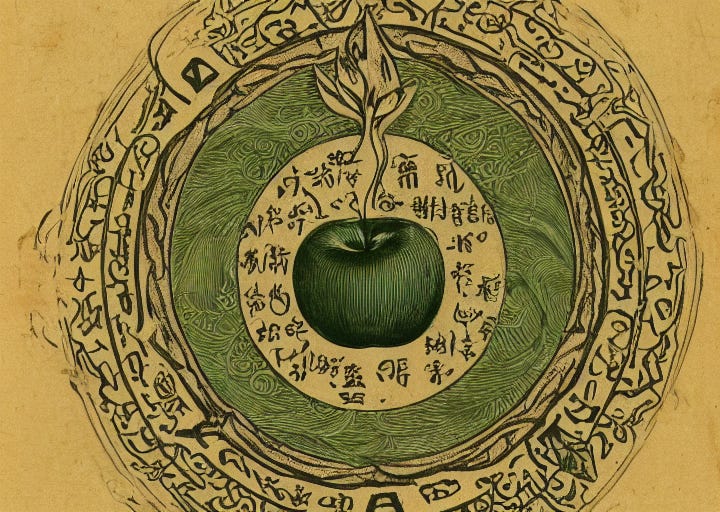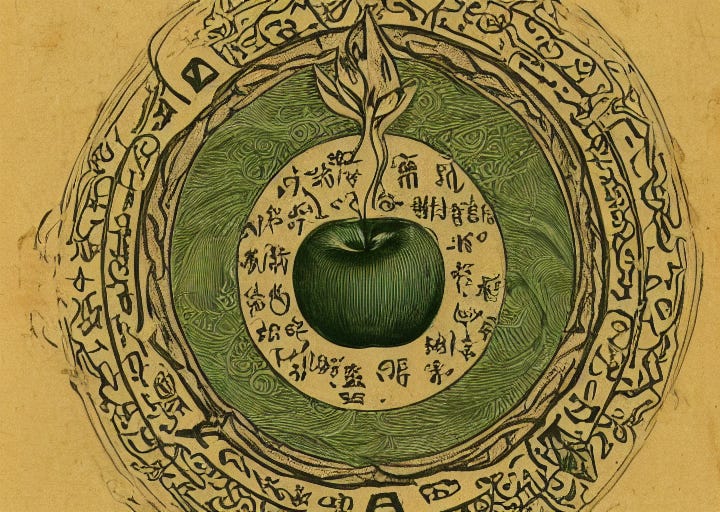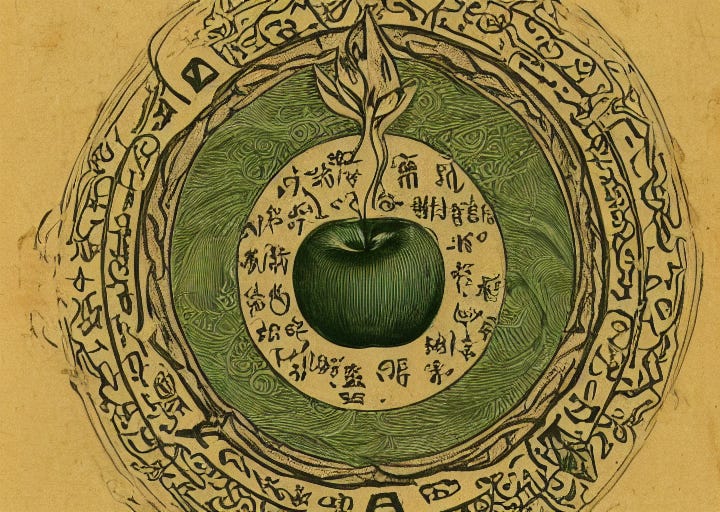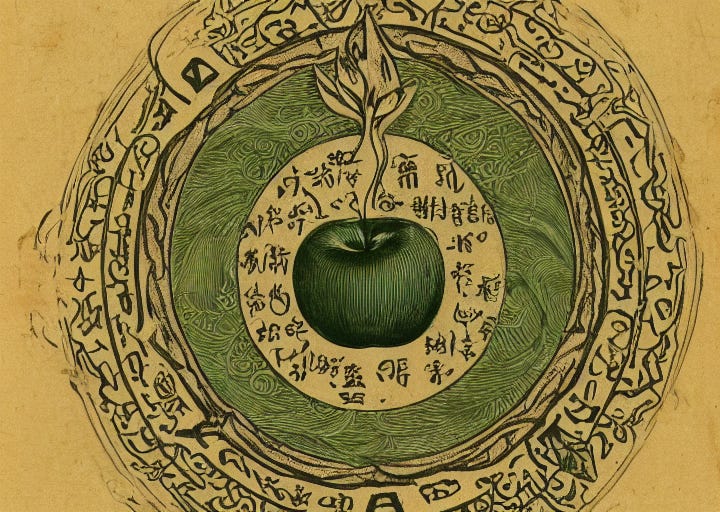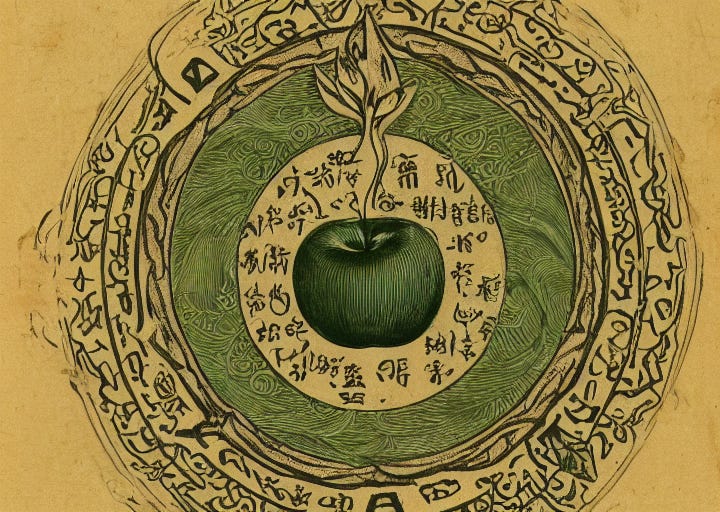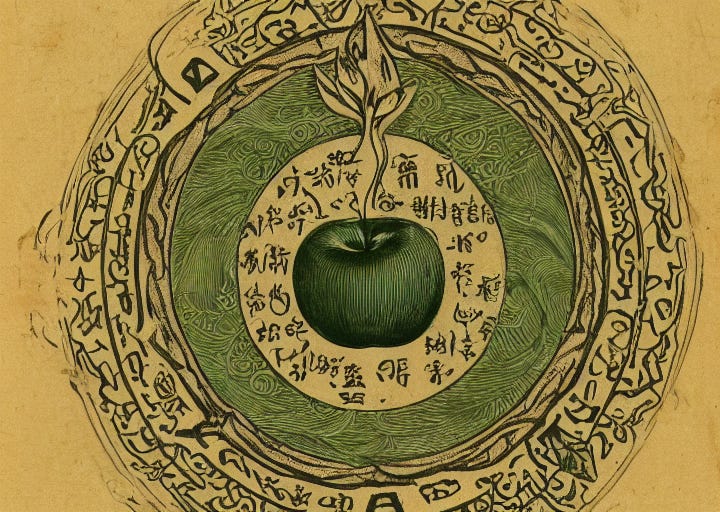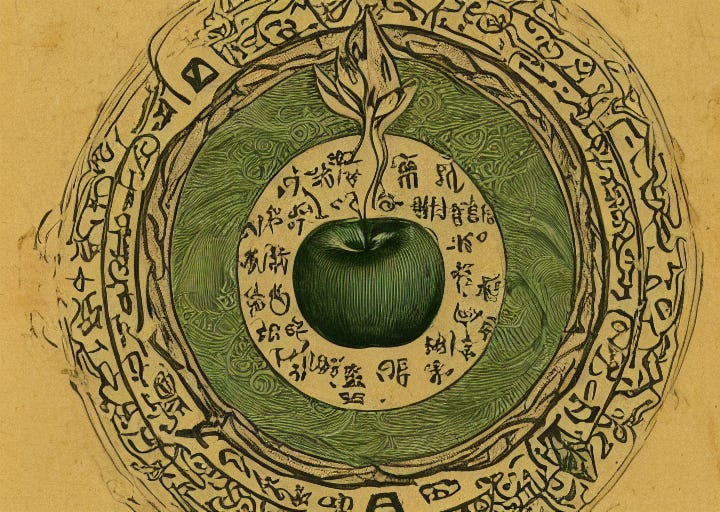Discover thegreengage exploring the hidden connections between nature; mind, and science.
thegreengage exploring the hidden connections between nature; mind, and science.

 thegreengage exploring the hidden connections between nature; mind, and science.
thegreengage exploring the hidden connections between nature; mind, and science.
Author: Green Gage exploring Cannabis, Psilocybin, and Ayahuasca
Subscribed: 1Played: 1Subscribe
Share
© Végé Gage
Description
Our AI-generated |thegreengage| voiced and naturally researched by myself exploring arcane connections between nature; mind, and science.
What if decoding matter could decode the mind?
Each episode is an island.
We blend neuroscience, chemistry, anthropology, history, & philosophy to explore how consciousness is shaped by molecules.
Using cannabis, psilocybin, & DMT as case studies, this series dives into the neurochemical basis of thought, emotion, identity, & altered states.
Curious about the brain, plant medicines, or the self?
This podcast invites critical thinking & respectful engagement with ancient wisdom & modern science.
thegreengage.substack.com
What if decoding matter could decode the mind?
Each episode is an island.
We blend neuroscience, chemistry, anthropology, history, & philosophy to explore how consciousness is shaped by molecules.
Using cannabis, psilocybin, & DMT as case studies, this series dives into the neurochemical basis of thought, emotion, identity, & altered states.
Curious about the brain, plant medicines, or the self?
This podcast invites critical thinking & respectful engagement with ancient wisdom & modern science.
thegreengage.substack.com
19 Episodes
Reverse
This episode is designed for educational and artistic purposes only, to inform mature audiences. It explores ideas related to various substances and must not be interpreted as promoting illegal use or activities. Viewers and readers are responsible for knowing and complying with local laws. If you or someone you know is struggling with mental health, substance use, or addiction, please seek help from a qualified healthcare professional or contact a local support service.What if molecules could wear masks?Not as myth or metaphor alone, but as reflections of how they move through consciousness. This episode invites us into the symbolic theatre of neurochemistry, where cannabis and psilocybin take the stage not just as substances, but as archetypes: recurring roles in the story of the human mind.Through the lens of both neuroscience and mythology, we explore how molecular action becomes symbolic personality and how these archetypes, in turn, shape identity, culture, and even law.🌿 In this episode, we explore:* Cannabis as the StabilizerActing through the endocannabinoid system, cannabis tunes the nervous system toward balance. It eases pain, slows perception, and thickens time: a molecule of grounding and gravity. Yet its gift of calm can also turn to inertia, fog, or forgetfulness. The stabilizer comforts, but also cautions: balance must stay alive, not stagnant.* Psilocybin as the RevealerBinding to serotonin 2A receptors, psilocin loosens the Default Mode Network: unbinding thought loops, fusing sensory and emotional circuits. The result? Revelation. Psilocybin is the archetype of insight, the teacher who unveils hidden patterns and forgotten truths. But revelation can overwhelm; its light is dazzling, not gentle.* Neuroscience Meets NarrativeReceptor activity and archetypal symbolism are not opposites but mirrors.The ECS feels stabilizing because it is.The serotonergic flood feels revealing because it literally opens communication between brain networks.Science describes the mechanism; story translates the meaning.* The Theatre of MindIn the drama of consciousness, molecules are actors. Cannabis dims the lights and deepens stillness; psilocybin floods the stage with imagery and voice. Each plays a role, not by intent but by the way we experience their presence: as dialogue partners in the inner world. This is why ritual and set-and-setting matter: they give the archetype a script to speak through.* Culture as ReflectionArchetypes extend beyond neurons into society.Cannabis cultures mirror its stabilizing tone: rhythmic, communal, meditative; while psilocybin cultures embody revelation and transformation. Even laws and stigmas echo these personalities: the “lazy stoner,” the “mad mystic,” projections of collective archetypes onto policy.🧠 Why it mattersTo understand a substance, it isn’t enough to map its receptors, we must map its myth.Each molecule carries both biological truth and symbolic meaning, co-created through human encounter.In recognizing chemical personalities, we glimpse a deeper truth: molecules are not just arrangements of atoms. They are arrangements of meaning.👿 Coming nextIf cannabis stabilizes and psilocybin reveals, what happens when a molecule doesn’t just ground or unveil, but transports?When it feels less like a companion or teacher and more like a messenger from beyond?In our next episode, we meet DMT: the molecule of the messenger, the emissary, the dream made chemical. 😏 Get full access to thegreengage at thegreengage.substack.com/subscribe
This episode is designed for educational and artistic purposes only, to inform mature audiences. It explores ideas related to various substances and must not be interpreted as promoting illegal use or activities. Readers are responsible for knowing and complying with local laws. If you or someone you know is struggling with mental health, substance use, or addiction, please seek help from a qualified healthcare professional or contact a local support service.If biology has a prime directive, it’s balance. Not stillness—dynamic equilibrium. From breath and heartbeat to mood and memory, the nervous system constantly negotiates a moving target called homeostasis. When trauma and chronic stress hijack those set points, anxiety, pain, and insomnia can become the “new normal.”This episode traces how two major neuromodulatory systems help restore that balance:* the endocannabinoid system (ECS), tuned by cannabis,* the serotonin system, engaged by psilocybin.In this episode, we cover1) Homeostasis & identityHomeostasis isn’t just survival math; it underwrites a continuity of self. Feedback loops (HPA axis, autonomic tone, thalamic filtering) keep physiology—and our lived sense of “me”—coherent. Dysregulation fractures that continuity.2) The Endocannabinoid System — the body’s internal balancerCB1 (brain/spinal) and CB2 (immune) receptors, with on-demand messengers anandamide and 2-AG, form retrograde “brakes” that prevent runaway signaling.* THC can strongly modulate CB1 (perception, memory, time).* CBD acts more subtly (supports anandamide tone, anti-inflammatory effects).Under chronic stress and PTSD, ECS tone can drop; targeted cannabis may ease pain, improve sleep, reduce hyperarousal—a nudge back toward center (with the caveat that overuse can push balance the other way).3) The Serotonin System — the psychedelic resetPsilocybin → psilocin binds 5-HT2A, loosening rigid cortical patterns (DMN downshift; cross-network “global integration”). Short term: more entropy/flexibility; longer term: a chance to recalibrate maladaptive set points. Patients often describe this as a “reset”—not erasure, but reopened possibility.4) Two tools, two tempos* Cannabis/ECS: regulates the now (sleep, pain, affective edges).* Psilocybin/serotonin: re-patterns the how (habit loops, belief rigidities), especially when paired with preparation and integration.5) Healing as balance, not perfectionHealth isn’t a flat line; it’s the capacity to wobble and return. From yin-yang to modern neurobiology, illness reads as imbalance; recovery is resilience—the nervous system’s ability to flex without breaking.Practical takeaways* Name your baseline: What does “balanced” feel like for you (sleep, appetite, focus, social connection)? Track it.* Match tool to task: Acute insomnia/pain/anxiety → consider ECS-supportive strategies; entrenched depressive loops → consider evidence-based, supervised psychedelic therapy where legal.* Context is medicine: Set, setting, and integration determine what sticks. Plan your aftercare (sleep hygiene, journaling, therapy, movement, nature).* Dose the lifestyle, too: Breathwork, sunlight, protein timing, and circadian cues are powerful homeostatic levers.Listen: (YouTube) • (Podcast) • (Apple) Get full access to thegreengage at thegreengage.substack.com/subscribe
This episode is designed for educational and artistic purposes only, to inform mature audiences. It explores ideas related to various substances and must not be interpreted as promoting illegal use or activities. Readers are responsible for knowing and complying with local laws. If you or someone you know is struggling with mental health, substance use, or addiction, please seek help from a qualified healthcare professional or contact a local support service.Back in Episode 11 we asked, what makes a trip? Today we return to the answer’s beating heart: set and setting. Psychedelics aren’t light switches; they’re amplifiers. Chemistry opens the door, but mindset and environment decide which room you walk into.Why this mattersSet & setting isn’t “harm reduction.” It’s a framework for understanding how psychology, space, culture, and relationship co-create entheogenic outcomes: from terror to awe, from confusion to clarity.In this episode, we cover* Origins of the phrase: From Leary/Metzner/Alpert’s 1960s insight—psychedelics as “nonspecific amplifiers”, to its deeper roots in Indigenous ritual containers (Mazatec veladas, Shipibo icaros).* Set (inner): Mood, expectations, intention, personal history; predictive processing and the DMN; why preparation (fasting, prayer, therapy, journaling) “tends the soil.”* Setting (outer): Space, music, people, culture; why a supportive room with skilled guides is an active ingredient, not décor.* Cultural containers vs. clinical frames: Temple and clinic as different, yet valid, hearths for the same spark; reciprocity and humility when borrowing lineages.* Integration: How set & setting extend through time; practices that weave insights into daily life (reflection, therapy, art, movement, time in nature, community).* Practical takeaways: Prepare the mind, curate the space, choose trustworthy company, and plan for integration; because the session isn’t the finish line, it’s the threshold.Key ideaThe chemical is the spark; set and setting are the hearth. With a hearth, fire becomes warmth, light, and sustenance.Three practical prompts* Intention: One sentence you’re willing to remember mid-storm.* Care team: Who holds space before, during, and after? Name them.* Integration plan: One practice you’ll do within 48 hours (journal, walk, call, art piece).Listen: (YouTube) • (Podcast) • (Apple) Get full access to thegreengage at thegreengage.substack.com/subscribe
This episode is designed for educational and artistic purposes only, to inform mature audiences. It explores ideas related to various substances and must not be interpreted as promoting illegal use or activities. Readers are responsible for knowing and complying with local laws. If you or someone you know is struggling with mental health, substance use, or addiction, please seek help from a qualified healthcare professional or contact a local support service.Among the Mazatec, mushrooms are not objects; they are beings.Teonanácatl — the Nahuatl name meaning “the flesh of the gods” — entered ceremony as sacrament, medicine, and dialogue. In candle-lit veladas, curanderas and curanderos sang in Mazatec, pairing mushrooms to honor balance, seeking diagnosis, guidance, and healing rather than spectacle.From Sahagún’s accounts of Aztec festivals to carved “mushroom stones” and debated rock art, the human story keeps circling the same intuition: fungi as thresholds — not for escape, but for encounter. Centuries later, colonial suppression tried to silence these rites; yet the songs survived in whispers. The twentieth century’s “rediscovery” — Wasson’s Life article, María Sabina’s veladas, Hofmann’s synthesis — brought psilocybin to science while fracturing the worlds that had carried it.This episode asks how we remember rightly: with context, consent, and reciprocity.🔎 In this episode, we explore:* Mazatec practice & meaning: veladas, paired mushrooms, healing aims, prayer in Mazatec.* Mesoamerican lineages: Aztec codices, “mushroom stones,” ritual pairings with pulque; continuity in Mixtec/Zapotec/Mazatec oral histories.* Traces & debates: Tassili n’Ajjer and Selva Pascuala rock art (what we can and cannot conclude); Siberian Amanita parallels; entheogens across cultures.* Eleusis as echo, not equivalence: the kykeon and fungal/fermented sacraments shaping cosmology and ethics.* Suppression & survival: Inquisition-era bans, clandestine ceremonies, knowledge transmitted in secrecy.* Rediscovery & rupture: Wasson in Huautla, María Sabina’s life and losses, Hofmann’s isolation of psilocybin, labs and counterculture.* Appropriation vs. reciprocity: why lineage, language, consent, and benefit-sharing matter in the “psychedelic renaissance.”* Walking forward with care: cultural humility, restorative storytelling, and supporting the communities that kept the fire.Core idea: Psilocybin’s history is not a straight line from “myth” to “science.” It is a spiral of revelation, suppression, and renewal — reminding us that molecules travel fastest when stories are honored.Listen: (YouTube) • (Podcast) • (Apple) Get full access to thegreengage at thegreengage.substack.com/subscribe
This episode is designed for educational and artistic purposes only, to inform mature audiences. It explores ideas related to various substances and must not be interpreted as promoting illegal use or activities. Readers are responsible for knowing and complying with local laws. If you or someone you know is struggling with mental health, substance use, or addiction, please seek help from a qualified healthcare professional or contact a local support service.In our last episode, we looked at how psilocybin seems to lift depression, ease anxiety, and even bring peace to those facing death. Today we go deeper—into the living architecture that makes such change possible: neuroplasticity.For a century the brain was imagined as a machine: fixed wiring, gradual decay, little hope of renewal. But that metaphor failed the living truth. The brain is not a black box; it is a garden—growing, pruning, grafting new paths across time. Plasticity is how we learn, heal, and become.Psychedelics like psilocybin appear to open windows of heightened plasticity—brief periods when the brain is unusually flexible, unusually receptive. Old loops loosen. New associations take root. What seemed locked can move again.🔎 In this episode, we explore:* What is neuroplasticity?Structural change (new synapses, dendritic growth) and functional re-mapping (regions sharing or shifting roles). From London taxi drivers’ hippocampi to cross-modal plasticity in blindness, the brain redraws its own maps.* Critical learning windows—reopened.Childhood is not the only portal. Evidence suggests psychedelics can rekindle sensitive periods: psilocybin promotes synaptogenesis; connectivity expands; habit-loops soften. Huxley’s “reducing valve” meets modern network science.* Trauma and reprocessing.Trauma is plasticity caught in a loop—fear pathways wired hard. In a supportive setting, psychedelics can thaw the frozen narrative: memories re-encoded with safety, compassion, and context. Not erasure—re-narration.* Therapy timelines, compressed.Weekly erosion vs. catalytic quake: preparation → session → integration. Psychedelics don’t replace the slow work; they can accelerate it—if the container is strong.* The double edge.Plasticity enables growth and entrenchment alike. Set, setting, screening, and integration determine whether the soil grows weeds or medicine.Core idea: Psychedelics don’t just change consciousness; they change the conditions of consciousness—making flexibility possible again so new meanings, behaviors, and selves can form.Listen: (YouTube) • (Podcast) • (Apple) Get full access to thegreengage at thegreengage.substack.com/subscribe
This episode is designed for educational and artistic purposes only, to inform mature audiences. It explores ideas related to various substances and must not be interpreted as promoting illegal use or activities. Readers are responsible for knowing and complying with local laws. If you or someone you know is struggling with mental health, substance use, or addiction, please seek help from a qualified healthcare professional or contact a local support service.Depression often narrows life into loops: rumination, numbness, the feeling of being locked in. Psilocybin doesn’t “numb” those loops but it seems to open them. In this episode, we trace how a fleeting mushroom alkaloid can catalyze durable changes in mood, perspective, and behavior when given with care.🔎 In this episode, we explore:* Clinical evidence at the edge of suffering: trials in treatment-resistant depression and end-of-life anxiety showing rapid, sometimes months-long improvements after 1–2 guided sessions.* Neuroplasticity & networks: psilocybin becomes psilocin, engages 5-HT2A receptors, quiets the Default Mode Network, and increases cross-talk between distant brain regions: loosening rigid patterns.* The emotional “reset”: less amygdala reactivity to fear, more capacity to feel and process like catharsis instead of suppression; clarity instead of looping.* Psilocybin vs. SSRIs: daily, incremental management vs. rare, catalytic sessions; dampening symptoms vs. reorganizing patterns; approaches that can be seen as complementary rather than competitive.* Set, setting, and integration: why preparation, supportive guides, music, eyeshades, and post-session integration matter as much as receptors.* Limits & cautions: not a cure-all; not for everyone; risks and contraindications exist: context, screening, and professional oversight are essential.Core idea: psilocybin doesn’t just change consciousness; it changes the conditions of consciousness—opening cognitive, emotional, and narrative flexibility so new meanings can take root. Get full access to thegreengage at thegreengage.substack.com/subscribe
This episode is designed for educational and artistic purposes only, to inform mature audiences. It explores ideas related to various substances and must not be interpreted as promoting illegal use or activities. Viewers and readers are responsible for knowing and complying with local laws. If you or someone you know is struggling with mental health, substance use, or addiction, please seek help from a qualified healthcare professional or contact a local support service.Psilocybin doesn’t just change consciousness: it changes the conditions of consciousness.In this episode, we follow the molecule from ingestion to insight: how psilocybin becomes psilocin, how it loosens the brain’s default narratives, and why the inner world can feel newly vivid, emotional, and spacious.🔎 In this episode, we explore:* The Default Mode Network (DMN): why the brain’s “storyteller” can become a tyrant, and how psilocybin quiets its grip.* Hyperconnectivity: novel conversations across distant brain regions (memory ↔ vision, emotion ↔ cognition) and what that feels like from the inside.* Emotion and fear processing: reduced amygdala reactivity, catharsis, and the sense of finally setting down a long-carried weight.* Mystical-type experiences: what clinical research measures, and why participants describe meaning beyond measurement.* The container: preparation, guided session, and integration — how set and setting shape outcomes as much as receptors do.* Paradox and practice: why brain scans show disintegration while the person reports union, insight, and renewal.Psilocybin is not a myth or a metaphor here, it’s a molecule shifting circuits, redirecting currents, and retuning the mind’s architecture. What science maps as connectivity, many experience as freedom. Get full access to thegreengage at thegreengage.substack.com/subscribe
This episode is designed for educational and artistic purposes only, to inform mature audiences. It explores ideas related to various substances and must not be interpreted as promoting illegal use or activities. Viewers and readers are responsible for knowing and complying with local laws. If you or someone you know is struggling with mental health, substance use, or addiction, please seek help from a qualified healthcare professional or contact a local support service.Somewhere in the quiet shade of the forest, a mushroom pushes through soil.Inside it, a molecule waits.Psilocybin.Across continents and centuries, humans have found this compound and given it names: food of the gods, flesh of the gods, teonanácatl. Today, science calls it psilocybin: a tryptamine, close cousin to serotonin, and one of the most studied psychedelic molecules on Earth.But what is psilocybin, really? A chemical formula on a lab sheet? A key that opens neural doors? A sacred presence woven into ritual?🔎 In this episode, we explore:* The basic chemistry of psilocybin and its conversion into psilocin* Why its structure mirrors serotonin, and what that means for the brain* How Indigenous cultures understood and revered it long before pharmacology* What modern science has discovered about its effects on mood, perception, and neuroplasticity* Why a single molecule can ripple into myth, medicine, and meaningPsilocybin is more than a drug.It is a bridge — between chemistry and culture, brain and spirit, science and story. Get full access to thegreengage at thegreengage.substack.com/subscribe
This episode is designed for educational and artistic purposes only, to inform mature audiences. It explores ideas related to various substances and must not be interpreted as promoting illegal use or activities. Readers are responsible for knowing and complying with local laws. If you or someone you know is struggling with mental health, substance use, or addiction, please seek help from a qualified healthcare professional or contact a local support service.Why does a handful of molecules so tiny, almost weightless have the power to unravel reality?What we call a trip is not a single thing. It’s the interplay of chemistry, context, and consciousness. Molecules like psilocybin, LSD, or DMT interact with brain networks that shape identity and perception. But the outcome whether it be awe, terror, healing, insight depends on far more than receptors alone.🔎 In this episode, we explore:* The neurochemical spark: how psychedelics activate and destabilize the Default Mode Network* The role of serotonin and dopamine in shaping perception, meaning, and intensity* Why “set and setting” matter as much as molecular action* How the brain weaves symbols and stories into raw sensory floods* Why some experiences feel divine, while others feel disorientingA trip is not just brain chemistry.It is brain chemistry meeting the mind’s vast architecture of memory, culture, and myth.And in that encounter, the ordinary self loosens and something other emerges. Get full access to thegreengage at thegreengage.substack.com/subscribe
This episode is for educational purposes only. It is intended for mature audiences and explores scientific, historical, and cultural perspectives on psychoactive substances. Nothing in this content should be interpreted as medical advice or encouragement for illegal activity. Viewers are responsible for knowing and following their local laws. If you or someone you know is struggling with substance use or mental health, please seek support from a qualified healthcare provider.Psychedelics don’t invent new worlds.They rearrange the tuning.And the key they use is serotonin.In this episode, we follow the thread from simple biology to altered states of mind. Serotonin receptors, especially the mysterious 5-HT2A, act as gateways, not just for mood, but for the patterns that structure thought and self. When psychedelics enter the picture, these gateways open wider than usual, letting the current of consciousness flow in unexpected directions.🔎 In this episode, we explore:* How psychedelics mimic serotonin yet bend it toward visionary states* The role of the 5-HT2A receptor as a portal of perception* Why “disruption” of normal brain networks can feel like both chaos and revelation* How dopamine’s reward and motivation circuits intersect with psychedelic states* How ancient rituals intuited these effects long before neuroscience named themSerotonin is the tuning fork.Psychedelics strike it with a different hand.And the resonance is what we call the psychedelic experience. Get full access to thegreengage at thegreengage.substack.com/subscribe
This episode is for educational purposes only. It is intended for mature audiences and explores scientific, historical, and cultural perspectives on psychoactive substances. Nothing in this content should be interpreted as medical advice or encouragement for illegal activity. Viewers are responsible for knowing and following their local laws. If you or someone you know is struggling with substance use or mental health, please seek support from a qualified healthcare provider.We’ve all heard the story.Serotonin: the “happiness chemical.”Too little, and you’re depressed.Boost it, and you’re back to normal.It’s a neat narrative. Comforting.But like most comforting stories, it’s incomplete.In this episode, we explore serotonin not as a single note of happiness, but as the tuning fork of the brain. A molecule that doesn’t just adjust volume: it sets rhythm, balance, and resonance.Far from being about “mood” alone, serotonin touches almost everything: sleep, appetite, memory, social bonds, even the fragile architecture of the ego itself. And the most surprising part? Over 90% of it isn’t even in your brain.🔎 In this episode, we cover:* Why serotonin is more than the “happiness chemical”* How it shapes perception, rhythm, and sense of self* The gut–brain connection and where most serotonin is really found* Why this molecule is central to both everyday experience and psychedelic journeysSerotonin isn’t just a switch for happiness. It’s a hidden system of tuning, weaving context into consciousness. Get full access to thegreengage at thegreengage.substack.com/subscribe
This episode is for educational purposes only. It is intended for mature audiences and explores scientific, historical, and cultural perspectives on psychoactive substances. Nothing in this content should be interpreted as medical advice or encouragement for illegal activity. Viewers are responsible for knowing and following their local laws. If you or someone you know is struggling with substance use or mental health, please seek support from a qualified healthcare provider.In Episode 8, we take a step back, way back.Before the receptors.Before the psychedelics.Before the mind was even a scientific question.We trace the long arc from ancient alchemy to modern neurochemistry, and ask:How did manipulating matter lead us to question the mind?This episode travels through:⚗️ The esoteric roots of chemistry: from transformation to transmutation🔬 The rise of laboratory science: and the industrial economy that fueled it🧠 The birth of neurochemistry as a serious science of the soul📉 The impact of war, profit, and pharmacology on how we study consciousness🌍 And how spiritual inquiry was rebranded as scientific “objectivity”What emerges is not a clean timeline, but a pattern.A poetic throughline, where the search for gold became the search for serotonin.Where philosopher-scientists became drug developers.And where the lab became a new kind of altar.If we want to understand the modern psychedelic renaissance, we have to understand how we got here, chemically, culturally, and economically.This episode sets the stage for everything to come, especially as we begin to explore how psychedelics helped force science to look inward again.As always, thank you for listening, reading, and wondering alongside me. Get full access to thegreengage at thegreengage.substack.com/subscribe
This episode is for educational purposes only. It is intended for mature audiences and explores scientific, historical, and cultural perspectives on psychoactive substances. Nothing in this content should be interpreted as medical advice or encouragement for illegal activity. Viewers are responsible for knowing and following their local laws. If you or someone you know is struggling with substance use or mental health, please seek support from a qualified healthcare provider.Posted for all subscribers. Full script and bibliography available to paid supporters.In this episode, we turn inward: from the molecules themselves to the maps they follow.We begin with a simple question:How does a puff of smoke or a drop of DMT produce a shift in mood, memory, or meaning?The answer, almost always, begins with the receptor.This episode traces:🧠 How the discovery of receptors transformed neuroscience🌀 Why "locks and keys" are more poetic and powerful than they sound📡 How psychedelic substances interact with specific neural circuits🧬 The brain’s natural “listening stations” and what they’re tuned to hear🕸️ What the receptor model reveals about connection, perception, and even selfhoodWe explore how chemicals don’t force effects on the brain, they participate in a dialogue. A whisper into a system already wired for meaning.To feel anything is to be in relationship.And to alter that feeling is to shift the pattern of connection between molecules, between neurons, between worlds.As always, this project is ad-free, independently made, and crafted for those who believe that the mind is more than matter, and that matter might just be meaning in disguise.Thanks for being here. Get full access to thegreengage at thegreengage.substack.com/subscribe
This episode is for educational purposes only. It is intended for mature audiences and explores scientific, historical, and cultural perspectives on psychoactive substances. Nothing in this content should be interpreted as medical advice or encouragement for illegal activity. Viewers are responsible for knowing and following their local laws. If you or someone you know is struggling with substance use or mental health, please seek support from a qualified healthcare provider.In Episode 6, we go deeper into cannabis, not as a single drug, but as an ecosystem of molecules.We explore the nuanced chemistry behind the entourage effect. How cannabinoids like THC & CBD interact with aromatic terpenes like limonene and myrcene to shape mood, memory, and perception. It's not just what’s in the plant, it’s how the molecules communicate.Because cannabis isn’t one voice.It’s a chorus.And the body doesn’t just receive it passively: it listens, filters, and responds.This episode covers:🌿 The major cannabinoids and what they do (scientifically, not sensationally)🎺 Why whole-plant medicine feels different than isolates🌱 How terpenes function like emotional context, not just scent🧬 The biological logic of synergy and polypharmacology in action⚖️ And why effects are relational, not linearWe also reflect on what it means to listen to the plant not just biochemically, but culturally.🔓 Paid subscribers get the full episode script + citations + notes.As always, Green Gage’s is ad-free, algorithm-free, and built for people who believe consciousness deserves careful language.Thanks for listening, reading, and thinking with me. Get full access to thegreengage at thegreengage.substack.com/subscribe
This episode is for educational purposes only. It is intended for mature audiences and explores scientific, historical, and cultural perspectives on psychoactive substances. Nothing in this content should be interpreted as medical advice or encouragement for illegal activity. Viewers are responsible for knowing and following their local laws. If you or someone you know is struggling with substance use or mental health, please seek support from a qualified healthcare provider.THC and anandamide. One from the plant. One from the brain. Both speak the same chemical language.In this episode, we take a closer look at two molecular messengers: THC, the psychoactive compound in cannabis, and anandamide, its naturally occurring counterpart in the human brain.What do these two molecules reveal about memory, motivation, and mood? And what happens when balance between them is lost?We explore how both compounds interact with the endocannabinoid system, not to override it, but to tune it. And in doing so, we trace the fine line between euphoria and dysregulation, between enhancement and escape.In this episode, we cover:• How THC and anandamide compare structurally and functionally• Why cannabis feels so familiar to the brain• The role of anandamide in stress recovery, memory, and pleasure• How THC mimics, amplifies, and sometimes disrupts the ECS• The science of balance and what long-term cannabis use may do to it• A reframe of cannabis: not just a substance, but a signalThis episode lays the groundwork for understanding cannabis not as a single effect, but as a spectrum and how context, chemistry, and internal state all shape the outcome.Green Gage’s is a 44-part exploration of consciousness through the lens of chemistry, neuroscience, and poetic insight.🔎 Keywords: THC vs anandamide, cannabis science, endocannabinoid system, how THC works, natural cannabinoids, cannabis and memory, neurochemistry podcast, ECS modulation, Green Gage’s, psychoactive balance, cannabinoid receptors📥 Follow & Subscribe for weekly episodes.**📩 Share your thoughts, questions, or reflections in the comments.Welcome to Green Gage’s. Let’s begin. Get full access to thegreengage at thegreengage.substack.com/subscribe
This episode is for educational purposes only. It is intended for mature audiences and explores scientific, historical, and cultural perspectives on psychoactive substances. Nothing in this content should be interpreted as medical advice or encouragement for illegal activity. Viewers are responsible for knowing and following their local laws. If you or someone you know is struggling with substance use or mental health, please seek support from a qualified healthcare provider.A system hidden in plain sight. A molecule named after bliss. A plant that revealed it all.Welcome to Episode 4 of thegreengage a podcast exploring the secret symphony of nature, mind, and science.In this episode, we trace the astonishing story of the endocannabinoid system a vast, overlooked regulatory network inside the human body, first discovered because of cannabis.From underground labs in 1960s Israel to breakthrough receptor mapping in the U.S., we follow how the study of THC led to the discovery of a system built not for intoxication, but for balance.In this episode, we cover:• The discovery of THC and the mystery of how it worked• The emergence of CB1 and CB2 receptors in the brain and immune system• The brain’s own cannabis-like molecules: anandamide and 2-AG• How the ECS maintains internal balance: from stress to sleep to inflammation• Why cannabis acts not as an invader, but as a mirror of our internal intelligence• The clinical relevance of ECS dysregulation and its role in resilienceThis is not just a story about a plant. It’s a story about how a plant helped science rediscover the body’s own language of equilibrium.Green Gage’s is a 44-part journey into the chemistry of being — blending neuroscience, story, and psychoactive insight.🔎 Keywords: endocannabinoid system, THC receptors, anandamide, what is ECS, cannabis and homeostasis, neuroscience podcast, psychoactive systems, CB1 CB2 explained, bliss molecule, resilience biology, Green Gage’s📥 Follow & Subscribe for weekly episodes.**📩 Share your questions or reflections in the comments.Welcome to Green Gage’s. Let’s begin. Get full access to thegreengage at thegreengage.substack.com/subscribe
Neurons. Narratives. Identity. Molecules. Memory.Welcome to the third episode of TheGreenGage — a podcast and video series exploring the arcane connections between nature, mind, and science.You are made of stardust — but feel like a person. Why?In this foundational episode, we unravel the layered relationship between the brain, the mind, and the self. Through the lens of neuroscience, philosophy, and chemistry, we explore how consciousness emerges from matter — and how psychoactive substances don’t just shift biology, but alter the story of who we are.In this episode, we cover:The difference between brain, mind, and self — and why that mattersHow physical matter becomes lived experienceThe mystery of subjectivity: from stardust to sentienceThe narrative self: how memory and mood shape identityWhy molecules like serotonin and anandamide influence not just our biology, but our beingHow psychoactive substances bridge these levels — from neurons to narrativeThis episode sets the stage for everything that follows. Because before we can ask how cannabis, psilocybin, or DMT affect us, we must first ask: what is the "us" being affected?Green Gage’s is more than a podcast. It’s a guided journey into the chemistry of being. Through a blend of neuroscience, story, and curiosity, we’re laying the groundwork for a 44-part course on psychedelics, neurochemistry, and the mystery of mind.🔎 Keywords (for search/discovery): brain vs mind, what is the self, neuroscience podcast, consciousness science, serotonin and identity, psychoactive effects on the self, chemical self, psychedelic philosophy, narrative brain, default mode network, brain and consciousness, thegreengage, mind-body connection📥 Subscribe. 🔔 Follow for weekly episodes. 📩 Share your questions or reflections in the comments.Welcome to Green Gage’s. Let’s begin. Get full access to thegreengage at thegreengage.substack.com/subscribe
Psychoactives. Neurotransmitters. Altered States. Brain Chemistry. Conscious Experience.Welcome to the second episode of TheGreenGage — a podcast and video series exploring the arcane connections between nature, mind, and science.What is a psychoactive substance, really? Is it just something that gets you high? Makes you hallucinate? Changes your mood? In this foundational episode, we challenge pop culture clichés and define what actually qualifies as "psychoactive" — and why these molecules deserve a more nuanced conversation.We explore how certain compounds interact with the brain’s neurotransmitter systems — not as magic bullets, but as messengers that reveal just how interconnected biology, experience, and meaning really are.In this episode, we cover:A clear and accessible definition of psychoactive substancesThe surprising ubiquity of these compounds — including ones you probably consumed todayThe brain as a chemical system: how neurotransmitters like serotonin, dopamine, and anandamide shape experienceHow psychoactives either mimic, block, or modulate these natural brain chemicalsWhy these substances are tools — not shortcuts — to altered statesWhat their effects reveal about the architecture of perception, memory, and emotionThis episode invites you to think differently about what these molecules actually do. Not just recreational tools or therapeutic options, but windows into the deepest structure of consciousness itself.Green Gage’s is more than a podcast. It’s a guided journey into the chemistry of being. Through a blend of neuroscience, story, and curiosity, we’re laying the groundwork for a 44-part course on psychedelics, neurochemistry, and the mystery of mind.🔎 Keywords (for search/discovery): what is a psychoactive substance, psychedelic podcast, cannabis, psilocybin, DMT, serotonin, dopamine, anandamide, endocannabinoid system, neurotransmitters explained, consciousness science, neuropharmacology, altered states, philosophy of mind, brain chemistry, chemical consciousness, psychoactive definition, thegreengage, science of the self📥 Subscribe.🔔 Follow for weekly episodes.📩 Share your questions or reflections in the comments.Welcome to Green Gage’s. Let’s begin. Get full access to thegreengage at thegreengage.substack.com/subscribe
Alchemy of the Inner World | Ep. 1 — TheGreenGagePsychedelics. Neurochemistry. Consciousness. History. Transformation.Welcome to the first episode of TheGreenGage a podcast and video series exploring the hidden architecture of consciousness through the lens of chemistry, history, and ancient wisdom.In this pilot episode, we ask:What if the science that transformed matter could also help us decode the mind?We trace the transformation of alchemy into chemistry, and how that ancient drive to purify base matter mirrored a deeper impulse to understand ourselves. From lead to gold, from myth to molecule, this episode lays the foundation for a 44-part journey into what we call the alchemical self.This is not just the story of drugs. It’s the story of how molecules shape experience, how the brain speaks in chemistry, and how science and spirituality might not be opposites — but mirrors.The forgotten roots of chemistry in alchemical traditionsThe historical shift from symbol to scienceThe rise of neurochemistry and how it bridges matter and mindWhat neurotransmitters like serotonin, dopamine, and anandamide actually doWhy consciousness might be chemical, but also cultural, historical, and cosmicHow cannabis, psilocybin, and DMT reveal the deeper design of the selfWhat it means to explore the inner world with rigor and humilityYou’ll walk away from this episode with a new lens on the mind, not as something separate from the body, but as something shaped by molecules, culture, memory, and mystery. We explore why psychoactive substances deserve careful, creative attention, not just as “drugs,” but as tools of insight.Green Gage’s is a space for conscious consumption and thoughtful education. Through science, storytelling, and personal reflection, we investigate how psychedelics, consciousness, neuroplasticity, and ancient traditions are converging in the modern world.Our course-style structure invites listeners to go deeper — with episodes that blend neuroscience, pharmacology, anthropology, philosophy, and more. Whether you’re new to this world or already curious, you’ll find something here to expand your understanding.🔎 Keywords (to help with SEO):psychedelics, cannabis, psilocybin, DMT, chemistry of consciousness, alchemy and chemistry, history of science, neuroscience podcast, neurochemistry, psychoactive substances, serotonin, dopamine, anandamide, endocannabinoid system, philosophical podcasts, psychedelic education, drug war history, alchemical self, TheGreenGage podcast, how psychedelics affect the brain, plant medicine, healing and consciousness, inner transformation📥 Subscribe.🔔 Hit the bell to follow each weekly episode.📩 Reach out with questions, feedback, or reflections in the comments.Welcome to Green Gage’s. Let’s begin. Get full access to thegreengage at thegreengage.substack.com/subscribe


